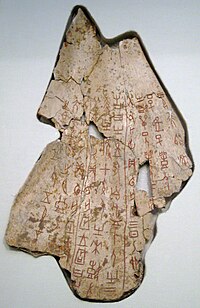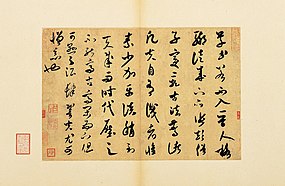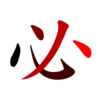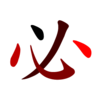Chinese letters
| Chinese letters | ||
|---|---|---|
| Font | Logography | |
| languages |
Standard Chinese Mandarin Wu Min Yue / Cantonese Gan Jin Kejia / Hakka Xiang |
|
| Emergence | 1000 BC | |
| Usage time | still ongoing | |
| Used in |
East Asia Southeast Asia |
|
| Officially in |
|
|
| Derived |
Kanji Hiragana Katakana Hanja Chữ nôm Sawndip Yi (script) Women's script Large Kitan script Xixia script (Tangut script) |
|
| particularities | Traditional characters and abbreviations | |
| Unicode block | U + 4E00..U + 9FD5 U + 3400..U + 4DBF U + 20000..U + 2A6DF U + 2A700..U + 2B734 U + 2B740..U + 2B81D U + 2B820..U + 2CEA1 |
|
| ISO 15924 | Hani Hant (traditional symbol) Hans (symbol) |
|
The Chinese script (Chinese 中 文字 , Pinyin zhōngwénzì , Zhuyin ㄓ ㄨ ㄥ ㄨ ㄣ ˊ ㄗ ˋ ) or Hànzì ( 漢字 / 汉字 , hànzì , Zhuyin ㄏ ㄢ ˋ ㄗ ˋ - " Han script") fixes the Chinese languages , especially the standard Chinese , with Chinese characters. It is thus a central bearer of Chinese culture and served as the basis of the Japanese scripts ( Kanji , Hiragana , Katakana ), one of the Korean scripts ( Hanja ) and one of the Vietnamese scripts ( Chữ nôm )
There are a total of over 100,000 characters , the majority of which, however, are rarely used or are uncommon, were only used temporarily in the past or represent variants. Knowledge of 3000 to 5000 characters is sufficient for everyday needs.
overview
A character basically represents a syllable as the sound structure of a morpheme . However, the Chinese script is not a phonographic syllabary like the Korean, because identical syllables are not represented by a single character, but different morphemes with the same sound structure are represented by different characters. The Chinese writing is therefore known as morphemic or morphosyllabic writing and is the only writing system still in use that does not primarily use the sound of a language, but rather has meaning-referring (semantic) elements in the majority of its characters.
The Chinese script is used in particular to write standard Chinese: in China and Singapore in the simplified form of the short characters , in Taiwan, Hong Kong and Macau still in the traditional form of the traditional characters . As a cultural export, the Chinese script reached neighboring countries around 600–800 AD and is still used in South Korea and Japan as part of the national writing systems. The traditional characters are also used there, although in Japan in a moderately simplified form since shortly after the Second World War.
By the end of the empire, the Chinese script was mainly to write the classic literary language " 文言 , Wenyan " used which was comprehensible only an educated elite. Since then, the Chinese script has mainly been used to write the standard script language " 白話文 / 白话文 , báihuàwén ", which grammatically resembles modern northern dialects and can be learned more easily than wényán by speakers of southern Chinese languages. Despite the heterogeneous language situation, Chinese writing serves as a supraregional medium of communication for all Chinese who can read báihuàwén (with whatever pronunciation). For this reason, for example, many programs on Chinese television are subtitled with the Chinese script. In addition to pure writing skills, the modern media and comprehensive instruction mean that the spoken standard Chinese " 普通話 / 普通话 , pǔtōnghuà " is increasingly becoming common knowledge.
Since the 15th century , an independent script based on the Chinese script has existed in the province of Hunan especially for use by women, the Nüshu , which was only used by them .
Categories of characters
The Chinese script mainly consists of logograms , but for the phonetic spelling of foreign words, some of them are sometimes used as phonetic signs . In general, a syllable is associated with a character. Traditionally, according to the first dictionary of characters in Chinese writing, the Shuowen Jiezi (2nd century), characters are divided into six categories based on the way in which they are formed or derived. A few are pictograms ( 象形 , xiàngxíng ) and symbols or simple ideograms ( 指 事 , zhǐshì ). A third small group are the compound ideograms ( 會意 / 会意 , huìyì ). The vast majority (over 90%) are phonograms ( 形 聲 / 形 声 , xíngshēng ). The last two categories are borrowings ( 假借 , jiǎjiè ) and synonyms ( 轉 注 / 转 注 , zhuǎnzhù ). This distinction between the characters in groups is called Liushu ( 六 書 / 六 书 , liùshū ), the six categories of Chinese characters.
meaning
The meaning of writing in China is mainly made up of two aspects.
- It documents the writing culture of the Chinese people , which is more than three thousand years old, and thus strengthens national awareness.
- Their mastery marks degrees of social prestige in modern Chinese society.
In Europe it is generally assumed that the prerequisite for the invention of writing was the need for management (of grain, water). In the earliest times, therefore, scripts would have developed primarily in empires with settled people engaged in agriculture or hydraulic cultures (such as Sumerians, Egyptians). In China, on the other hand, the general opinion prevails that the oldest fragments of scripture that can be seen are the inscriptions on oracle bones . In a figurative sense, this means that the prevailing opinion is that writing emerged from the motivation to construct a medium for communication with an otherworldly, shamanistic spirit world. Something magical is suggested to the origins of Chinese writing.
In China, linear and uninterrupted sequences of character variants were established. On the other hand, the continuity of writing in Chinese language history can only be traced back to the Shang dynasty . The connection to older archaeological finds is still a research topic. In contrast to European writing systems, attempts were made in Chinese only at the beginning of the Latinization efforts to find explicit written characters as representatives of the smallest individual sounds of the language. The official units of the written language, however, are the characters handed down from Chinese culture (which usually represent whole syllables).
The importance of writing in modern China is constituted in particular by the fact that the monopoly of education no longer lies with a specific social class, as in ancient China with the civil servants or, as in the European Middle Ages, the Latin script with the clergy. Events such as the May Fourth Movement and the Baihua Movement contributed to the fact that the prestige of a vernacular language rose in contrast to the classical educational language and that the claim arose to spread the written culture to the whole people. The prevailing opinion is that literacy and reading skills are an educational asset that all Chinese should strive for equally. Accordingly, the communist government consistently fights illiteracy (better: illiteracy).
Historical development of the Chinese script
History up to the People's Republic of China
The Chinese writing is over 3000 years old and thus has the longest unbroken tradition in East Asia. The oldest Chinese characters found so far are in cattle bones (especially in the shoulder blade, so-called oracle bones ) and turtle shells (for prophecy of the hunt etc.) carved symbols from the time around 1400 BC. BC, which were discovered in Anyang in 1899 . It is assumed that 5000 different characters already existed at that time.
In the middle of the first millennium BC, pictorial writing developed into a marketable font that was able to completely map the syntax and semantics of some of the languages of that time in the area of today 's People's Republic of China . With the unification of the Chinese empire under the first emperor Qin Shihuangdi in 221 BC. A great standardization of script took place.
In conjunction with the since the unification ( Qin Dynasty ) established bureaucratic state , the Chinese written language was their use in the entire catchment area of the Chinese Empire to the lingua franca that connected the various Chinese language communities together and allowed a relative unity of the Chinese cultural area.
In China, politicians and officials had to be good writers into the 20th century if they wanted to gain influence - and not, as in the West, good speakers. In many places it is described how disappointed many Chinese were when they heard politicians like Mao Zedong or Deng Xiaoping speak for the first time.
| Oracle bones | Bronze inscription | Large seal script | Small seal font | Chancellery | Rule script | Simplified |

|

|

|

|

|

|

|
Writing reform in the People's Republic of China
On January 28, 1956, at the 23rd plenary session of the State Council of the Central Committee of the Communist Party of China, the "Concept for Simplifying Chinese Characters" was adopted and published on January 31 by the daily Renmin Ribao . When simplifying the characters, a large number of spellings were used that were already used in handwritten texts in the time of the North and South Dynasties . Many abbreviations were used by poets in the Tang Dynasty . In the Kingdom of the Taiping rebels abbreviations have also been used, of which were incorporated in the People's Republic of China on 50 pieces in the "plan to reduce the Chinese characters". The commitment to the introduction of symbols begins with the activities of intellectuals of the May Fourth Movement , such as Qian Xuantong .
Examples of simplifications are 图 for 圖 ( tú , map ), 龙 for 龍 ( lóng , dragon ) and 单 for 單 ( dān , single ). Methods of simplification were, for example, connecting dots to form lines ( 馬 mǎ , horse , became 马 ), omitting dashes or dots ( 爲 or 為 wèi , doing , became 为 ) or combining two or three long characters to an abbreviation ( 復 fù , restore , and 複 fù , complex , have been combined to form the simplified character 复 ).
The writing reforms in the People's Republic of China relate not only to reducing the number of strokes within a character, but also to the definition of a standardized sound of a character, the definition of a standardized font, the definition of the number of characters in common use, as well on a systematization of the characters, for example in the arrangement in lexicons. Parallel to the simplified characters, the traditional long characters are still used in part and have returned to everyday life since the increasing relaxation in the People's Republic. However, it is not possible for an average educated Chinese to read the long characters of old texts that have not been transmitted.
In Taiwan as well as in Hong Kong and Macau the tradition of writing with long characters was retained because the reforms of 1958/1959 were not carried out there. It is also common among overseas Chinese . So the symbolic meaning of the signs and radicals remained recognizable. In handwritten texts, however, a whole series of abbreviations are traditionally common, some of which correspond to the abbreviations of the People's Republic of China.
The Singapore government has joined the People's Republic of China's writing reforms and has also been using Chinese abbreviations and a horizontal writing style since the 1970s.
Number of characters
The Shuowen Jiezi , a dictionary from the year 100 AD, contains 9,353 different characters (1163 variants not counted); the Kāngxī zìdiǎn from 1716 contains 40,545 different characters and the Zhōnghuá zìhǎi ( 中華 字 海 / 中华 字 海 ) from 1994 contains around 87,000 different characters and variants. The variant dictionary of Chinese characters ( The Dictionary of Chinese Variant form 異體字字典 , yìtǐzì zìdiǎn ) the Ministry of Education in Taiwan has more than 100,000 characters .
In practice, however, the number of characters actually used is considerably fewer. For example, Article 7 of the 1993 Anti-Illiteracy Regulations of the PRC defines literacy in Chinese as being able to read and write between 1,500 and 2,000 characters . A modern bilingual standard dictionary (The New Chinese-German Dictionary, Xin Hande cidian 新 漢 德 詞典 / 新 汉 德 词典 ) contains around 6,000 characters.
In the People's Republic of China ( Mainland China ) the number of characters ( abbreviations ) for necessary everyday use is set at 3500 by the state. (As of 1988) These characters are separated by the list of "characters for everyday use" - 常用 字 - "1st degree everyday characters" - with 2000 characters - and the list of "characters for secondary use" - 次 常用 字 - "2nd everyday characters Grades ”- further subdivided with 1500 characters. In the Hong Kong Special Administrative Region , the comparable general " List of characters for everyday use ( traditional characters )" - 常用 字 字形 表 - 4759 characters. (As of 2000) In Taiwan , the general “National Standard Character List for Everyday Use ( Traditional )” - 常用 國 字 標準 字體 表 - 4808 characters. (As of 1979) In Japan, however, the number of comparable kanjis ( Shinjitai ) is 2136 in the so-called list of kanjis for everyday use - 常用 漢字 jōyō kanji , German 'everyday use characters' , which in turn are divided into 10 levels - from 1 to 10 Difficulty levels according to school year - are divided. (As of 2010) In South Korea , where the Hanja - Chinese characters - have not been officially taught in schools since the early 1970s and are only offered as voluntary additional lessons in secondary schools, the general number is to be taught Characters 1800. (Status 1972) In countries like China and Japan, the number of individually controllable characters can thus indirectly reflect the level of education of a person in general or in a specific area.
Fonts
In the course of Chinese history, the following fonts in particular can be made out outside of word processing devices:
| German | Alternatively | Hanzi 1 - Langz. 2 | Hanzi - Abbrev. 3 | Pinyin | Hepburn | RR |
Italic font - 行書 , circa 1097-1099 - from Mi Fu Northern Song Dynasty |
|---|---|---|---|---|---|---|---|
| Oracle bone inscription | Oracle Bone Script | 甲骨文 | 甲骨文 | Jiǎgǔwén | Kokotsubun | Gapgolmun | |
| Bronze inscription | - | 金文 | 金文 | Jīnwén | Kinbun | Geummun | |
| Seal script | - | 篆書 | 篆书 | Zhuànshū | Tensho | Jeonseo | |
| Italics | Semi-italics | 行書 | 行书 | Xingshu | Gyōsho | Haengseo | |
| Grass script | Concept font | 草書 | 草书 | Cǎoshū | Sosho | Choseo | |
| Chancellery | Official font | 隸書 | 隶书 | Lìshu | Reisho | Yeseo | |
| Rule script | Block letters | 楷書 | 楷书 | Kǎishu | Kaisho | Haeseo |
- annotation
Typeface
Writing direction
The writing direction of the Chinese script in the premodern period was usually vertical from top to bottom, and the resulting columns were arranged from right to left. (Chinese 豎排 / 竖排 , shùpái ; Japanese: 縦 書 き tategaki )
Since the writing reform in the People's Republic of China, most books, like European books, have been written in lines from left to right and with lines arranged from top to bottom.
Books of literary content printed in Taiwan are still read top-down. However, this only applies to a limited extent for newspapers and magazines as well as factual texts and specialist books. In advertisements, and often in advertising, if Western (brand) names appear in the text, the spelling from left to right is used. In calligraphy and poetry, there is almost only the direction of writing from top to bottom.
Both variants are found in Japan, whereby literary texts are printed more in columns and factual texts in lines. In newspapers, both are used mixed up, which opens up more possibilities for an attractive layout without extremely short lines (or narrow columns).
Books printed from top to bottom , that is, books printed in Taiwan and most of the Japanese, are opened “at the back” in contrast to European books. If you look at the title page, the spine is on the right and not on the left as in Europe. Books in which the characters are arranged from left to right have the title page on the page we are used to and are opened and read like European books.
Inscriptions over portals and doors are more often written from right to left in the People's Republic of China. In Japan, as in Europe, portal headings are more likely to be written in lines from left to right, but in the case of historic buildings or traditional structures such as temples and shrines, they are almost exclusively written traditionally from right to left. In Taiwan, the inscriptions over temple gates and altars run from right to left.
The stroke order
| Nationally different stroke sequences of the character 必 (from black to light red) | |||
|
Chinese Empire |
Taiwan and Hong Kong |
People's Republic of China |
Japan |
When writing Chinese characters, the order of the individual lines is not arbitrary, but is determined by seven basic rules:
- First the horizontal, then the vertical line
- First the line bent to the left, then the line bent to the right
- First the top, then the bottom line
- First the left, then the right line
- First external, then internal components are written
- A box is not closed until the inner component is finished
- If smaller components are grouped around a larger middle section, the middle section is written first
These rules are interpreted differently for individual characters, as shown on the right using the example of the 必 character . With font styles such as italic and conceptual fonts , in which the writing brush is not lifted from the paper between all the strokes, and the strokes are thus connected, this sometimes leads to significantly different shapes of the same character.
| Direction of writing of the traditional character [ guī - 龜 ] for turtle | Direction of writing of the character [ jiǔ - 九 ] for "nine - 9" |
Compilation of words
In ancient and classical Chinese , most words were still one or two syllables or characters long. In North Chinese- based Baihua and the modern Standard Chinese that emerged from it after the May Fourth Movement (1919) , the average word length is longer. Most Chinese words consist of several syllables or characters. If the Chinese language is reproduced with Chinese characters, no word boundaries are indicated with the help of spaces or other means. All characters are equidistant from one another. However, if standard Chinese is written in Latin using the spelling rules of the popular Pinyin system, then, similar to German, multi-part words are written together and these words are separated from one another by spaces.
punctuation
The punctuation ( 標點 / 标点 , biāodiǎn ) in its current form was only introduced gradually in the 20th century through contact with the West. However, scratched lines can already be seen in the early historical bone inscriptions, which probably served to delimit semantic units. Punctuation was unusual in ancient Chinese texts, and readers could write the pauses ( 讀 / 读 , dòu ) into the texts themselves. These mostly consisted of a small circle " 。 " ( 圈 , quān ) or a point ( 點 / 点 , diǎn ). The process of writing the punctuation into the text has been called a sentence caesura ( 句 讀 / 句 读 , jùdòu ) since the Han period . Great scholars could be recognized by the sovereign manner in which they punctuate. There are still editions of classics in Taiwanese bookstores, in which the punctuation of famous scholars is noted.
Punctuation has been officially regulated in the People's Republic of China since September 1951. As of 1990 there are 16 punctuation marks, most of which correspond to those used in the West and are used in a similar way. The point “ 。 ” ( 句號 / 句号 , jùhào , see also the “circle” above) as well as the “lying” comma “ 、 ” ( 頓號 / 顿号 , dùnhào ) are particularly important .
Printing set
When printing Chinese texts, all characters, including punctuation marks, are placed in roughly square boxes of the same size. Characters with different spacing - cf. for example the Latin m opposite the i - therefore does not exist. In order to still be able to recognize the details of the most complicated characters with 20 or more lines, the overall font should not be too small. In the case of rarer characters, the pronunciation is often given next to it or above it very small (by Zhuyin . This was common in the PRC until 1956 and still in Taiwan , or by Furigana in Japan ).
Spaces between words are uncommon in Chinese script. As a result, there is no clear delimitation of the term “word” in the languages that use the Chinese script. Often even native speakers disagree on whether a certain element in a sentence is an ending or a separate word.
As soon as a line of text is full, it is broken anywhere; There are no separation rules. Only immediately before a punctuation mark is not separated, in this case a character is transferred to the next line.
Writing media
From ancient times to modern times
Silk and bamboo , which were written on cut into narrow boards (like Guodian bamboo texts ), are considered special writing substrates of ancient Chinese . Both are not found in ancient Europe, where the use of wax tablets, papyrus and parchment predominated.
China used paper as the first culture, the inventor of which is venerated to the Chinese Cai Lun ( 蔡倫 / 蔡伦 ), who is said to have had the groundbreaking idea for the development of the inexpensive writing medium in AD 105. It was not until the 12th century that paper came to Europe. It was used in Germany from around 1250 and was produced from the end of the 14th century.
The Chinese used brushes and black and red ink to calligraphy on paper and silk . Meng Tian ( 蒙恬 ) is considered to be the inventor of the brush in China . Indian ink has been made from the soot of pine wood since the Han period and marketed as a stick ink . Seal impressions were known long before the 14th century. Brush , ink , rubbing stone and paper are still considered to be the four treasures of the traditional scholar's room.
Despite the invention of paper, important (oldest) Chinese stone carvings from the fourth year of the government motto Xiping ( 熹平 ) of Emperor Han Lingdi of the Eastern Han Dynasty (175 AD) have been preserved, the classic works of the Confucian school , such as " Shijing "(the book of songs )," Shangshu "( book of documents )," Yili "( etiquette and rites )," Yijing "( I Ching )," Chunqiu "(the spring and autumn annals )," Gongyangchuan ", " Lunyu " ( Analects of Confucius ) have preserved. Further stone engravings are the three classics " Shangshu ", " Chunqiu ", " Zuozhuan " from the second year of the Zhengshi reign of the Wei Dynasty (241 AD), which are written in the fonts "Ancient Chinese Script" ( 古文 , gǔwén ), " Emperor Qin's seal script " and "simplified Chinese chancellery script " are fixed.
With the support of the missionaries, book printing prevailed in China and led to the expansion of print media, for example the Shanghai daily Shenbao. In modern day-to-day use, writing implements are commonly used in the West ; in writing lessons in primary schools in Taiwan, mostly with pencil in special exercise books with square writing fields.
computer
Chinese characters are written on the computer with the aid of various input systems for the Chinese writing . The input of texts on the PC takes place with a writing speed per sentence which corresponds approximately to what, for example, German word processors can achieve with German keyboards. In the Chinese-speaking countries and in Japan, new types of errors occur as an undesirable side effect when writing Chinese and Japanese texts.
When writing handwriting, however, the suggestions that computer-aided input systems make in dialogue are missing. Younger Chinese and Japanese people who are used to their input dialogues often have difficulties in writing characters that are used less frequently or expressing themselves without errors by hand. You can then look up these characters using the input system on your mobile phone or in electronic pocket dictionaries, which are often very extensive because the contents of several conventional dictionaries are stored in them.
calligraphy

The calligraphy is a highly respected art in China. Here, the characters are lively put on paper with a brush. These lettering are just as much art objects as paintings. It is even common in Chinese painting to incorporate characters into the picture; Unlike in South Asia, Buddhist mandalas in the Chinese cultural area are designed with characters rather than images.
In Japan, in contrast to China, according to the basic principle of Wabi-Sabi, the aim was often not to look beautiful in the classical sense, but rather to look “raw” and unfinished. Calligraphic works of art often adorn portals and rooms in Chinese architecture , such as pavilions in typical Chinese gardens, as Duilian in paired vertical writing tablets and as Yinglian as horizontal nameplates . They are almost inseparable from the garden structures and form important decorative elements in the Chinese landscape garden. The content of the pairs of sayings ( Duìlián ) of such boards and signs is generally related to the environment or the user of the rooms and buildings. Often these are lines from famous poems, in which special features of the scenery are indicated.
Calligraphy, along with other art forms , reached its artistic peak in the Tang Dynasty (618–907). The works of art by the famous calligraphers of the time - such as Wang Xizhi , Yan Zhenqing , Ou Yangxun and Liu Zongyuan - are still regarded as priceless treasures.
The value of “fine writing” is set very high in China. Calligraphic works have the same artistic value in the Chinese and Far Eastern cultural areas as paintings or sculptures in the Western West. This can be seen, for example, from the fact that the Republic of China in Taiwan includes calligraphic works by their previous presidents in the official biographies of their previous presidents.
Phonetic transcriptions
A character basically represents a syllable. To reproduce the pronunciation of a character, rhyming lexicons have been used in ancient China since the Sui Dynasty and Tang Dynasty , in which the sound of a syllable was not described by specifying the phone , but by specifying two other Chinese characters whose pronunciation was clear to the reader already had to be known. The first approved in the initial sound consistent with the desired syllable, the second in the final position ( Fanqie system).
The first attempts to transcribe the Chinese language were made in 1588 by the Italian missionary Matteo Ricci and the French missionary Nicolas Trigault . The missionaries tried to fix the sounds of the Chinese spoken language with letters from the Latin alphabet.
In 1892 Lu Zhuangzhang ( 盧 戇 章 / 卢 戆 章 ) developed a transcription for the dialect from Xiamen and called it “ qieyin xinzi ” ( 切音 新 字 - “New characters for divided sounds”). He is considered to be the first Chinese to design a transcription system for the Chinese script. According to his design, the movement for the transcription of the Chinese language at the end of the Qing Dynasty in China is called “ qieyinzi yundong ” ( 切音 字 運動 / 切音 字 运动 - “Movement for the characters for divided sounds”). Lu Zhuangzhang already had the idea of a uniform language and script for all of China.
By the time the Republic of China was founded , nearly thirty other transcription systems had been produced. Those made up of Latin letters made up about a quarter. The goal was to be able to learn the Chinese script more easily and thus to advance science and education in the course of modernization efforts. Among these transcription systems was the concept of Wang Zhao ( 王 照 ), who was influenced by the Japanese Kana in developing his concept.
The idea of using a uniform Chinese language can already be found among officials of the Qing Dynasty. Hence the name guanhua (official language), or Mandarin for Chinese. The idea of preventing a split into dialect groups in China and the idea of the necessity of a common national language within the heterogeneous language situation in China became particularly clear after the fall of the Qing Dynasty and the establishment of the Republic of China .
In 1913, therefore, the Beiyang government called the " Conference on the Standardization of Pronunciation " ( 讀音 統一 會 / 读音 统一 会 , dùyīn tǒngyī huì ). At the conference it was decided to introduce the " Zhuyin Zimu" (National Phonetic Alphabet, 注音字母 ). The writing reform in China was therefore accompanied by a language reform . Unlike the scripts created by the missionaries, this transcription system is a phonetic transcription made up of shortened Chinese characters.
Until the Communist Party came to power in 1949, other transcription systems were created using Latin letters. The most important are:
- Gwoyeu Romatzyh ( 國語 羅馬 字 / 国语 罗马 字 , Guoyu Luomazi - "Latin script of the national language")
- Latinxua Sin Wenz , short: Sin Wenz ( 拉丁 化 新 文字 / 拉丁 化 新 文字 , Ladinghua Xin Wenzi - " Latinized New Script")
Gwoyeu Romatzyh comes from Yuen Ren Chao ( 趙元任 / 赵元任 , Zhào Yuánrèn ) and was submitted to the Ministry of Education for publication on September 14, 1926.
The Sin Wenz has its origins in the Soviet Union. At the height of the Soviet Latinization movement, members of the Chinese Communist Party who were in Russia and Soviet linguists designed a system for transcribing the Chinese script with Latin letters, which was handed down to China in 1933 and called "Ladinghua Xin Wenzi". It sparked the mass language movement of Latinization ( 拉丁 化 群眾運動 / 拉丁 化 群众运动 , Ladinghua qunzhong yundong ), in which it claimed national distribution. It spread from Shanghai from 1934 . A prominent proponent was Lu Xun . However, it was banned by the Guomindang , and its spread had to cease in the areas conquered by the Japanese. In the areas controlled by the communists , however, it was used in evening schools and laid the basis for the development of pinyin after the communists came to power in 1949 .
Pinyin was in 1982 by the ISO recognized as an international standard for the transliteration of the Chinese and is available for Mandarin , the dominant transcription. In addition, the Latin transcription developed by Wade-Giles at the beginning of the 20th century is still in use, as is the non-Latin transcription Zhuyin (especially common in Taiwan). Other systems, mostly based on the language of the respective translator, no longer have any significant significance. Due to the various systems for Latinization, i.e. non-standardized transcription or transcription systems, the inconsistency of phonetic transcription, for example Mao Tse-Tung , Mao Zedong or Chiang Kai-shek or Chiang Kai Schek , comes about . For other Chinese languages, such as Cantonese , phonetic transcriptions are also being developed, but these are so far less mature than the Mandarin systems.
See also
literature
- Karl-Heinz Best , Jinyang Zhu: A Model for the Increase in Chinese Characters. In: Glottometrics 20, 2010, pp. 29–33 (PDF full text ). (Mathematical modeling of the expansion of the Chinese character inventory from approx. 200 BC)
- John DeFrancis : The Chinese Language, Fact and Fantasy . University of Hawaii Press, Honolulu 1984, 2005, ISBN 0-8248-1068-6 .
- John DeFrancis: Nationalism and Language Reform in China . Princeton University Press, Princeton NJ 1950, Octagon Books, New York 1972, ISBN 0-374-92095-8 .
- Helmut Martin : Chinese language planning . Studienverlag Brockmeyer, Bochum 1982, ISBN 3-88339-291-X .
- Dorothea Wippermann: The Phonetic Alphabet Zhuyin Zimu . Studienverlag Brockmeyer, Bochum 1985, ISBN 3-88339-483-1 .
- Andreas Guder-Manitius: Sinographical Didactics. Aspects of a systematic teaching of Chinese writing in Chinese as a foreign language. With a component analysis of the most common 3867 characters . Julius Groos, Heidelberg 1999, ISBN 3-87276-835-2 .
- Martin Woesler: The computer as an aid in Sinology for language acquisition, translation, library management. Europ. Univ.-Verl., Bochum 2004, ISBN 3-89966-027-7 .
- Cornelia Schindelin: On the phoneticity of Chinese characters in the didactics of Chinese as a foreign language. A synchronous phonetic analysis of 6,535 characters in use in the People's Republic of China. iudicium, Munich 2007, ISBN 978-3-89129-979-1 ( SinoLinguistica , Vol. 13)
- Edoardo Fazzioli: Painted Words. 214 Chinese characters. From image to concept. A key to understanding China, its people and its culture. Translated from the Italian by Anna Eckner. Gustav Lübbe Verlag, Bergisch Gladbach 1987, ISBN 3-7857-0476-3 .
- Rainer Hesse : Comprehensive analytical-synthetic reference dictionary of modern Chinese characters using the column method . Verlag BoD, 2011, ISBN 3-8391-7514-3 , ISBN 978-3-8391-7514-9 .
- Ernest Fenollosa : The Chinese character as a poetic medium . Edited by Ezra Pound . Vol. 2 of the series "Art and Environment", ed. v. Eugen Gomringer . Josef Keller Verlag Starnberg, 1972, ISBN 3-7808-0076-4 .
- Ruth Cremerius: Pronunciation and writing of Chinese . Buske, Hamburg 2012, ISBN 978-3-87548-426-7 .
- Rainer Hesse: Wangma fenleifa . Detailed description of the network code for the classification of Chinese characters. Otto Harrassowitz, Wiesbaden 1985, ISBN 3-447-02561-1 .
- Thomas O. Höllmann : The Chinese script . History, characters, calligraphy. Verlag CHBeck, Munich 2015, ISBN 978-3-406-68290-2 .
Web links
- General:
-
Dictionaries:
- Chinese-German dictionary (Chinese, German)
- Chinese Dictionary (Chinese, English)
- Xinhua Dictionary Online (Chinese)
- Handian Dictionary (Chinese, German, English, French)
- Dictionary of Chinese - Revised Edition - Ministry of Education, ROC (Chinese)
- Dictionary of Chinese Character Variants - Ministry of Education, ROC (Chinese)
- Richard Sears: Chinese Etymology - 字 原 - Etymological Dictionary of Chinese Characters (Chinese, English)
Individual evidence
- ↑ 《異體 字 字典》 網路 版 說明 - Character variant dictionary - explanations for the online version. In: dict2.variants.moe.edu.tw. Retrieved September 18, 2019 (Chinese).
- ↑ a b There are only a few exceptions to the rule that a character corresponds to a syllable. By far the most important is the 兒 / 儿 character , which is pronounced as the unsyllabic -r at the end of certain words in standard Chinese and even more frequently in the Peking dialect . There is also a group of rarer numerals such as 廿 , niàn - "20" and 卅 , sà - "30", which are often misread like the usual numerals 二十 , èrshí - "20" and 三十 , sānshí - "30" . Finally, there are rare abbreviations for words whose recommended spelling is multi-character, e.g. B. 浬 for 海里 , hǎilǐ - “nautical mile”, 瓩 for 千瓦 , qiānwǎ - “kilowatt” or 圕 for 圖書館 , túshūguǎn - “library”.
- ↑ 東京 大学 総 合 研究 博物館 デ ジ タ ル ミ ュ ー ジ ア ム ( Memento from August 3, 2003 in the Internet Archive ). In: Tokyo University Digital Museum website, accessed September 18, 2019 (Japanese)
- ↑ 《異體 字 字典》 網路 版 說明 - Character variant dictionary - explanations for the online version. In: dict2.variants.moe.edu.tw. Retrieved September 18, 2019 (Chinese).










